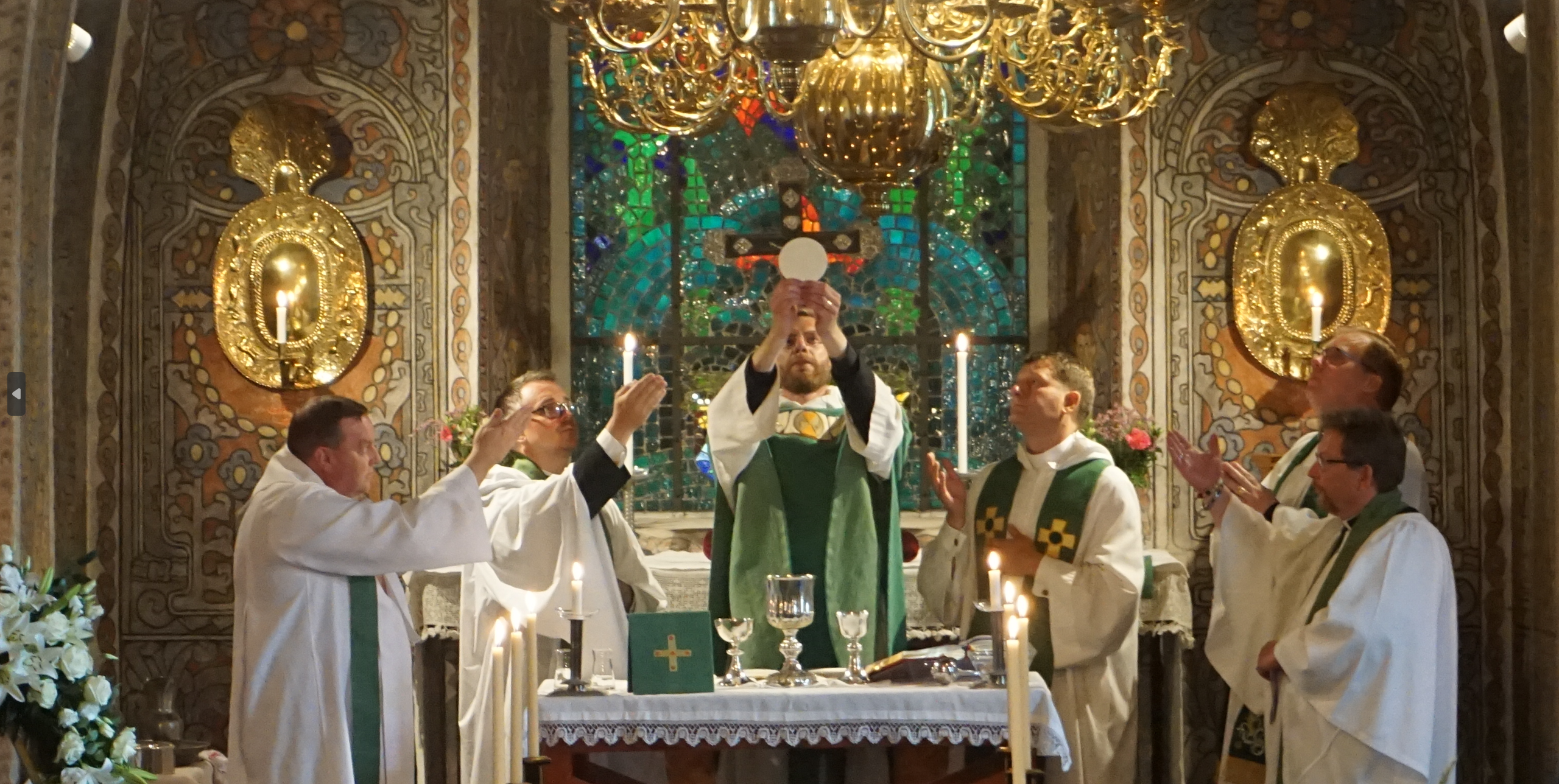|
UP Oblation
The Oblation (Filipino: ''Pahinungod'', ''Oblasyon'') is a concrete statue by Philippine National Artist Guillermo Tolentino that serves as one of the symbols of the University of the Philippines. It depicts a man facing upward with arms outstretched, symbolizing a selfless offering of oneself to his union. History The idea for the Oblation was conceived during the presidency of Rafael Palma, who was the one to commission Tolentino to make the sculpture. Palma requested that the statue would be based on the second verse of Rizal's '' Mi Ultimo Adios'': The concrete sculpture, painted to look like bronze, measures 3.5 meters in height, symbolizing the 333 years of Spanish rule in the Philippines.Michael Tan''The Oblation'' Pinoy Kasi. Retrieved October 6, 2007. The sculpture is replete with references to selfless dedication and service to the nation, and as Tolentino himself describes it, [...More Info...] [...Related Items...] OR: [Wikipedia] [Google] [Baidu] |
University Of The Philippines Visayas
The University of the Philippines Visayas (UPV or UP Visayas) is a public university, public research university in Iloilo, Philippines. A constituent university of the University of the Philippines system, it teaches management, accountancy, marketing, economics, chemistry, applied mathematics and physics, marine science education and research, fisheries, and aquaculture. It offers regional studies programs on the preservation and enrichment of the Visayan cultural heritage. UP Visayas has two campuses—Miagao and Iloilo City — with Miagao being the main campus where the central administration offices are located. Most of the students of the university are drawn from the Visayas and the Visayan linguistic groups. Many of the leaders of the Visayas graduated from UPV or its predecessor institutions. As of 2007, the Commission on Higher Education (Philippines), Commission on Higher Education of the Philippines awarded four National Centers of Excellence and Development to U ... [...More Info...] [...Related Items...] OR: [Wikipedia] [Google] [Baidu] |
UP Oblation
The Oblation (Filipino: ''Pahinungod'', ''Oblasyon'') is a concrete statue by Philippine National Artist Guillermo Tolentino that serves as one of the symbols of the University of the Philippines. It depicts a man facing upward with arms outstretched, symbolizing a selfless offering of oneself to his union. History The idea for the Oblation was conceived during the presidency of Rafael Palma, who was the one to commission Tolentino to make the sculpture. Palma requested that the statue would be based on the second verse of Rizal's '' Mi Ultimo Adios'': The concrete sculpture, painted to look like bronze, measures 3.5 meters in height, symbolizing the 333 years of Spanish rule in the Philippines.Michael Tan''The Oblation'' Pinoy Kasi. Retrieved October 6, 2007. The sculpture is replete with references to selfless dedication and service to the nation, and as Tolentino himself describes it, [...More Info...] [...Related Items...] OR: [Wikipedia] [Google] [Baidu] |
Streaking
Streaking is the act of running naked through a public area for publicity, for fun, as a prank, a dare, a form of protest, or to participate in a fad. Streaking is often associated with sporting events, but can occur in more secluded areas. Streakers are often pursued by sporting officials or the police. Definitions and etymology The word has been used in its modern sense only since the 1960s. Before that, ''to streak'' in English since 1768 meant "to go quickly, to rush, to run at full speed", and was a re-spelling of ''streek'': "to go quickly" (); this in turn was originally a northern Middle English variant of ''stretch'' (). In December 1973, a graduate of Carleton College in Northfield, Minnesota wrote to ''Time (magazine), Time'' magazine that the term "streaking" was coined because the nude students ran primarily during the winter months of January and February, and "unless one appeared as a streak against the landscape, the Minnesota winter was triumphant and streaker ... [...More Info...] [...Related Items...] OR: [Wikipedia] [Google] [Baidu] |
Alpha Phi Omega (Philippines)
The Alpha Phi Omega Philippines Incorporated, commonly known as Alpha Phi Omega Collegiate Service Fraternity and Sorority or simply Alpha Phi Omega or APO (), is a service fraternity and sorority in the Philippines founded in 1950. It is the first established national chapter of Alpha Phi Omega outside of the United States, although both organizations have separate leaderships and operate independently. Alpha Phi Omega has 250 chapters in the Philippines and 150,000 members as of 2010. Alpha Phi Omega commits to the "development of a world-class membership that cares for the quality of life with complete complement guided by the three cardinal principles of Leadership, Friendship, and Service." Founded under the ideals of the scouting movement, the fraternity uses scouting ideals such as the Scout Law as the basis for its code of conduct. History The Alpha Phi Omega in the United States was established by Frank Reed Horton on December 16, 1925, at Lafayette College. In 19 ... [...More Info...] [...Related Items...] OR: [Wikipedia] [Google] [Baidu] |
Oblation
An oblation is a solemn offering, sacrifice or presentation to God, to the Church for use in God's service, or to the faithful, such as giving alms to the poor. The word comes from the Late Latin ''oblatio'' (from ''offerre'', ''oblatum'' 'to offer'), 'an instance of offering' and by extension 'the thing offered'. Bible use The Latin Vulgate, and following this many English versions such as the KJV, 1611, uses the word to stand for the meal offering under the Law of Moses. Ecclesiastical use It is thus applied to certain parts of the Eucharistic service in Christian liturgies. The rites of Roman Catholicism, Eastern Orthodoxy, Lutheranism, and Anglicanism employ an oblation: gifts of bread and wine are offered to God. Liturgically speaking, there are two oblations: the lesser oblation, sometimes known as the offertory, in which the bread and wine, as yet unconsecrated, are presented and offered to God, and the greater oblation, the oblation proper, in which the Body and B ... [...More Info...] [...Related Items...] OR: [Wikipedia] [Google] [Baidu] |
Fernando Poe, Sr
Fernando is a Spanish and Portuguese given name and a surname common in Spain, Portugal, Italy, France, Switzerland, and former Spanish or Portuguese colonies in Latin America, Africa and Asia (like the Philippines, India, and Sri Lanka). It is equivalent to the Germanic given name Ferdinand, with an original meaning of "adventurous, bold journey". Given name * Fernando el Católico, king of Aragon A * Fernando Acevedo, Peruvian track and field athlete * Fernando Aceves Humana, Mexican painter * Fernando Alegría, Chilean poet and writer * Fernando Alonso, Spanish Formula One driver * Fernando Amorebieta, Venezuelan footballer * Fernando Amorsolo, Filipino painter * Fernando Antogna, Argentine track and road cyclist * Fernando de Araújo (other), multiple people B * Fernando Balzaretti (1946–1998), Mexican actor * Fernando Barrichello (born 2005), Brazilian racing driver * Fernando Baudrit Solera, Costa Rican president of the supreme court * Fernando Botero, C ... [...More Info...] [...Related Items...] OR: [Wikipedia] [Google] [Baidu] |
Germany
Germany, officially the Federal Republic of Germany, is a country in Central Europe. It lies between the Baltic Sea and the North Sea to the north and the Alps to the south. Its sixteen States of Germany, constituent states have a total population of over 84 million in an area of , making it the most populous member state of the European Union. It borders Denmark to the north, Poland and the Czech Republic to the east, Austria and Switzerland to the south, and France, Luxembourg, Belgium, and the Netherlands to the west. The Capital of Germany, nation's capital and List of cities in Germany by population, most populous city is Berlin and its main financial centre is Frankfurt; the largest urban area is the Ruhr. Settlement in the territory of modern Germany began in the Lower Paleolithic, with various tribes inhabiting it from the Neolithic onward, chiefly the Celts. Various Germanic peoples, Germanic tribes have inhabited the northern parts of modern Germany since classical ... [...More Info...] [...Related Items...] OR: [Wikipedia] [Google] [Baidu] |
Wilhelmsfeld
Wilhelmsfeld is a municipality in the Rhein-Neckar-Kreis of Baden-Württemberg in Germany. Geography Wilhelmsfeld is a state-certified climatic health resort in the hills of the southern Odenwald, between 260 and 533m above sea-level. The surrounding communities are Heidelberg, Schriesheim, Heiligkreuzsteinach, and Schönau. History Wilhelmsfeld was established in 1710, when Johann Wilhelm, prince-elector of the Electorate of the Palatinate, granted five farmers from the Steinach river valley the right to settle there. The settlement was named after the prince-elector, but it belonged to Heiligkreuzsteinach administratively. Wilhelmsfeld became independent in 1810, after the region was annexed by Baden. Government Municipal council The municipal council includes 14 councilors excluding the mayor (''Bürgermeister''). Coat of arms The coat of arms is based on a seal from 1818. The coat of arms was created by the General State Archive in 1911 on basis of the seal. The s ... [...More Info...] [...Related Items...] OR: [Wikipedia] [Google] [Baidu] |
Jose Rizal
Jose is the English transliteration of the Hebrew and Aramaic name ''Yose'', which is etymologically linked to ''Yosef'' or Joseph. Given name Mishnaic and Talmudic periods * Jose ben Abin * Jose ben Akabya *Jose the Galilean * Jose ben Halafta * Jose ben Jochanan * Jose ben Joezer of Zeredah * Jose ben Saul Male * Jose (actor), Indian actor * Jose Balagtas, Filipino film director *Jose Baxter (born 1992), English footballer * Jose Davis (born 1978), American football player * Jose Glover (died 1638), English minister and pioneer of the printing press in the New World * Jose Kattukkaran (born 1950), Indian politician *Jose Kurushinkal, Indian cricket umpire *Jose Kusugak (1950–2011), Inuk politician *Jose Lambert (born 1941), Belgian professor * Jose K. Mani (born 1965), Indian politician *Jose Mugrabi (born 1939), Israeli businessman *Jose Nandhikkara (born 1964), Indian author *Jose Pellissery (1950–2004), Indian film actor *Jose Chacko Periappuram (born 1958), Indian su ... [...More Info...] [...Related Items...] OR: [Wikipedia] [Google] [Baidu] |
University Of The Philippines Open University
The University of the Philippines Open University (UPOU) is a public research university and is the fifth constituent university of the University of the Philippines System. The majority of UPOU students are based in the Philippines but all of its programs can be taken anywhere in the world. While primarily a virtual university, it has a physical campus that houses admin and faculty offices in Los Baños, Laguna, with Mega Learning Hubs (MLH) in Manila and Cebu. UPOU was established in 1995 by the UP Board of Regents as the evolution of the UP Distance Education Program. UPOU offers accredited graduate and undergraduate degrees as well as diploma courses and Professional Teaching Certificates (PTC) to Filipino and international students in more than 70 countries. It also offers MOOCs on various subjects through its official platform, Massive Open Distance eLearning (MODeL), and hosts its degree programs through its official student portal, MyPortal, both learning platforms ... [...More Info...] [...Related Items...] OR: [Wikipedia] [Google] [Baidu] |
Philippine Collegian
The ''Philippine Collegian'', also known as ''Kulê'' (), is an alternative news outlet and the official student publication of the University of the Philippines Diliman. Established in 1922, the Collegian is commonly associated with the national democratic movement, with many of the publication's staffers opposing martial law under Ferdinand Marcos. The Collegian continues to publish views critical of the university administration and the Philippine government as a "mainstay of the Philippine democratic left." History Establishment and pre-war history The Collegian was first known as the ''College Folio'' (1910) and then ''Varsity News'' (1917). As the College Folio, it was one of the first undergraduate journals in the Philippines. The Philippine Collegian was officially established in 1922. Since then, it has become a symbol for academic freedom, critical thinking, and journalistic integrity and excellence. In 1935, the Collegian published Teodoro Agoncillo's review of Ri ... [...More Info...] [...Related Items...] OR: [Wikipedia] [Google] [Baidu] |



